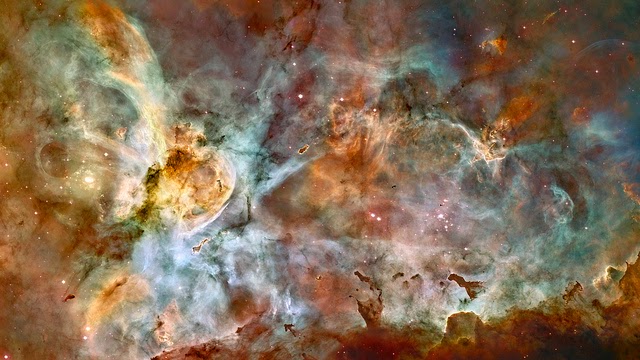You all know how spaced out I am, so you will not be surprised when I post another blog about space and the stuff out there. Our universe is such a beautiful, wonderful, dangerous, and explosive place. You know it all started with a huge explosion nicknamed The Big Bang? Well, it seems that a lot of things have been going bang ever since. OK, don't take my word for it, just look at the pictures that I posted below. I think I will put them in alphabetical order. This first one is the Butterfly Nebula:
Those wings of the Butterfly, although very pretty, are made up of really hot gas at 36,000 degrees and traveling at 600,000 mph, fast enough to travel from Earth to the Moon in 24 minutes.
This next one is Carina Nebula which is one of the most dynamic, complex places we know of in the Milky Way Galaxy:
The next one is the Cat's Eye Nebula. It was one of the first planetary nebulae discovered. It has eleven rings, and each one is a spherical bubble. Such beauty!! but also such a display of the gas bubbles being ejected by the dying star within:
The next one is the Crab Nebula. Chinese astronomers recorded this violent explosion almost 1000 years ago, back in 1054. It has already spread to six light years in width:
This star that is puffing off huge balls of gas is Eta Carinae, and that unstable center star is a hundred times more massive than our sun:
This next one is a young planetary nebula, the Hourglass Nebula. If there were any planets associated with any of these huge explosions, they would have been destroyed or shoved out into the darkness of space.
And this is one of the most popular and most observed nebula by amateur astronomers that don't have the access to the huge scopes. Of course it doesn't look like this through any backyard scope, not even my 16". You have to take long exposure pictures to start to see color. It looks bluish white when I look at it. If you haven't guessed yet, it is the Orion Nebula:
I will leave you with the image of this phenomenon called V838 Monocerotis. It is really not an object, I guess that is why they call it a phenomenon. OK, your guess is as good as mine, what is it, really?
Ok, that is all folks. I sure hope you enjoy the beauty of the universe as much as I do. Don't forget to look up at night, and have a great day, too, you hear?








Those are soooo beautiful. Guess i've never seen them in color.
ReplyDeleteIt takes a long exposure time before colors start showing up. Some amateurs take one hour exposures through red, green, and blue filters and an hour with no filters. Then they combine all five hours with to gets good view.
DeleteThey are all beautiful, especially the Cat's Eye Nebula.
ReplyDeleteYes, I would have to agree with you.
DeleteBeautiful.... some of them remind me of areas in Yellowstone NP....
ReplyDeleteThe one main difference is that the Yellowstone features are measures in feet but the space features above are measured in light years.
DeleteWonderful information Dizzy! Really loved it. It helped me to know more about our space. Thanks for sharing!
ReplyDeleteSpace really intrigues me. I want to get my big telescope out one of these nights.
Delete